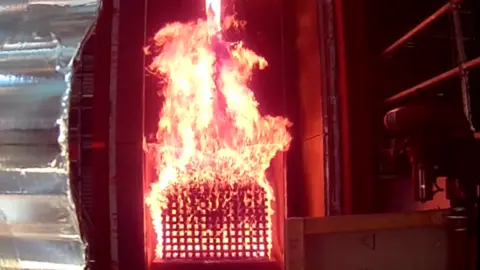Cladding: Panels failed fire tests 13 years before Grenfell
 MCRMA
MCRMALeaked test results suggest the government and construction industry had early evidence of the dangers posed by cladding, 13 years before the Grenfell Tower fire.
Panels, commonly used on buildings in the UK, failed fire tests carried out in 2004.
The results, marked "Commercial in confidence", were circulated within an industry advisory group.
They were recently passed to the BBC and, until now, never made public.
Hundreds of thousands of flat owners are now threatened with large bills because of construction materials which pose a risk in fires.
The 2004 results were among the first from a British test of full-scale building systems, developed in the late 1990s when there were growing concerns in Parliament about the risks of cladding.
The tests were part of research commissioned by the then Labour government to determine what standards building systems should have to meet.
Five cladding systems were tested, including one with aluminium panels, although the primary aim was not to assess the risk of particular designs
The aluminium and plastic cladding at Grenfell has been blamed for spreading the fire.
Two were constructed from high pressure laminate (HPL) boards, formed from wood, or paper fibre, widely used on modern apartment blocks in the UK.
In the tests, all five cladding systems were judged to have failed against "proposed performance criteria".
Most of the tests were carried out without using "fire breaks" - extra components which should be fitted to block the spread of flames.
However, fire breaks were used in one high pressure laminate panel system, but it still failed.
'I might be bankrupt'
Zoe Bartley bought a three-room flat in Chelmsford four years ago, and with her partner Ash, now has a baby.
They are desperate to move to a bigger home, but the cladding crisis means they cannot sell the flat.
It has HPL panels, as well as wooden balconies and missing fire breaks,
Zoe finds it "disgusting" that the test results were not circulated more widely.
The couple are anticipating a bill of tens of thousands of pounds to remove the dangerous materials, which could bankrupt them.
"There's no finish line, and it's all-consuming at times," Zoe says.
"We are very angry that we've been put in this situation.
"We've done everything right. Everything by the book: 'Buy a property and set yourself up for the future.'

"I might end up bankrupt by the time I'm in my 30s."
Her building is lower than 18 metres, so does not qualify for government funding.
The UK Cladding Action Group called the test results "staggering new evidence which shows the government and its advisers knew these materials were dangerous, but simply stood back and allowed them to be installed on hundreds of thousands of buildings.
"The British state knew from this moment on that it was gambling with a disaster in a high-rise, but it chose not to act."
'Route to disaster'
Jonathan Evans, director of Ash and Lacy, a major UK supplier of cladding systems, said he had never seen the results, and described them as "really vital bits of information" which would have helped assess fire risks after Grenfell.
He said that when poor test data is not made public, it creates a bias towards tests with successful outcomes.
"We all proceed along the route of thinking these systems are safer than they are, until there's a disaster."

He said a lack of public information about cladding systems in the 2000s may have resulted in governments not abandoning a controversial British standard for building materials, known as Class 0.
The Grenfell Tower inquiry has heard evidence that this standard was much easier to meet than a stricter European classification, and that keeping it as an option in England and Wales allowed combustible materials to be installed on thousands of buildings.
If Class 0 had been abandoned and a ban on combustible materials introduced, Grenfell might not have happened, Dr Evans said.
Tests 'experimental'
The Ministry of Housing, Communities and Local Government (MHCLG) described the 2004 tests as "experimental... for a different purpose" than the rounds of testing ordered in the wake of the Grenfell disaster.
They were carried out to "to check the criteria for testing" rather than to assess the "intrinsic safety of building materials", officials said.
The findings fed into a review of technical standards used by building designers to assess the safety of cladding.
An MHCLG spokesman said: "We are taking action to improve building safety where successive governments have failed, through our Building Safety Bill, which marks the biggest improvements to building safety in 40 years, with more rights and protections for residents and a £5bn investment to remove unsafe cladding.
"The new Building Safety Regulator will enforce a more stringent regulatory regime for buildings over 18m and oversee the safety and performance of all buildings, ensuring products are removed from the market if they do not meet regulation."
The Building Research Establishment, which carried out the tests and circulated them to the industry advisory group, refused to comment.
Next month the Grenfell Tower public inquiry will begin examining evidence of what governments knew about the risks of cladding fires before the 2017 disaster, and what they did about it.
